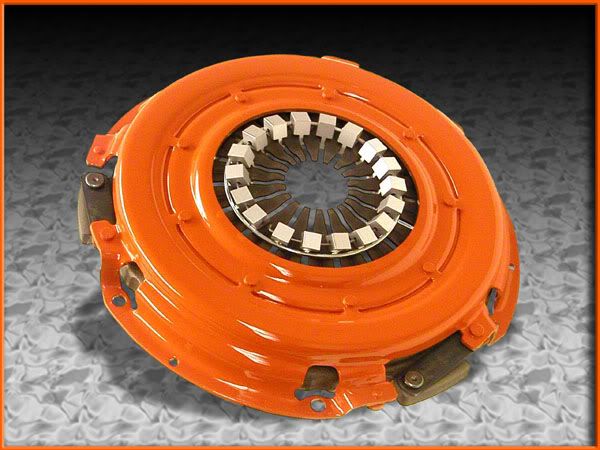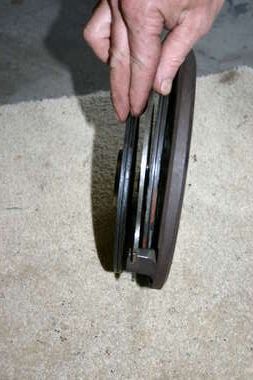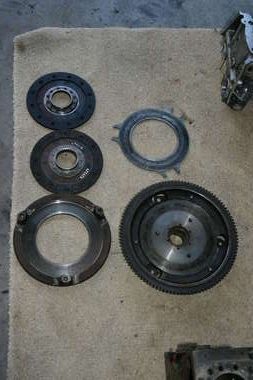| Page: |
| Home > Technical Chat > clutch thoughts | |||||||
 6752 Posts Member #: 828 Post Whore uranus |
18th Jul, 2006 at 05:35:55pm
had a think about clutches the other day ,and remembered that the clutch on my v8 has a system of rollers that fly out due to cetrifugal force ,and create more pressure on the plate , i think it goes up from 2200 to 2800 lb .
Edited by robert on 18th Jul, 2006. Medusa + injection = too much torque for the dyno ..https://youtu.be/qg5o0_tJxYM |
||||||
|
8604 Posts Member #: 573 Formerly Axel Podland |
20th Jul, 2006 at 04:32:32pm
For what its worth, I think this is worth considering further.
Saul Bellow - "A great deal of intelligence can be invested in ignorance when the need for illusion is deep."
|
||||||
 6752 Posts Member #: 828 Post Whore uranus |
20th Jul, 2006 at 06:32:06pm
i just had the idea ,axel , and have done no research at all!! :$ Medusa + injection = too much torque for the dyno ..https://youtu.be/qg5o0_tJxYM |
||||||
|
8604 Posts Member #: 573 Formerly Axel Podland |
20th Jul, 2006 at 06:35:36pm
I've got a spare used 0.095 thick diaphragm verto cover that we could use as a trial.
Saul Bellow - "A great deal of intelligence can be invested in ignorance when the need for illusion is deep."
|
||||||
 6752 Posts Member #: 828 Post Whore uranus |
20th Jul, 2006 at 08:08:26pm
cool , those are going to be some complicated calcs,with the force of the weight flying out ,acting in a rotating pivoting motion on the finger the flex of the finger ,the tangential force of the weight the distance of the weight from the pivot etc ,blimey !!prob better just to make it and spin it and see what the forces are with some sort of pressure plate force guage .probably hydraulic accting on a guage Medusa + injection = too much torque for the dyno ..https://youtu.be/qg5o0_tJxYM |
||||||
|
8604 Posts Member #: 573 Formerly Axel Podland |
20th Jul, 2006 at 08:20:35pm
Nah,
Saul Bellow - "A great deal of intelligence can be invested in ignorance when the need for illusion is deep."
|
||||||
|
Forum Mod 10980 Posts Member #: 17 ***16*** SouthPark, Colorado |
20th Jul, 2006 at 08:27:42pm
Big probs I see with this system is that it's not putting a huge amount more load on the setup where you actually want it - ie 3200-3500 ish RPM.
On 17th Nov, 2014 Tom Fenton said:
Sorry to say My Herpes are no better Ready to feel Ancient ??? This is 26 years old as of 2022 https://youtu.be/YQQokcoOzeY |
||||||
|
8604 Posts Member #: 573 Formerly Axel Podland |
20th Jul, 2006 at 09:11:41pm
Right while the creative juices are flowing and before I get packing for hols, I thought I'd do these calcs.
Saul Bellow - "A great deal of intelligence can be invested in ignorance when the need for illusion is deep."
|
||||||
 6752 Posts Member #: 828 Post Whore uranus |
21st Jul, 2006 at 08:24:37am
On 20/07/2006 20:20:35 Axel said:
Nah, Calculating centrifugal force is easy. mv2/r. Simple vector diagram to calculate the effect of the centrifugal force on the fingers, then multiply it by the ratio of the length of the diaphragm fingers to the pivot point and the length from the pivot point to the point of contact on the backplate. axel as he centrifugal force on the finger becomes greater the finger does 2 things ,it exerts more force on the pivot ,and also bends a little ,this bending motion will affect the calcs ,also as the finger moves outwards ,the direction of the angle of the weight to the finger changes and so the forces become greater ,until at a point where the finger would be straight out parralel to the axis of rotation the force would be greatest on the pivot point ,(this cant happen to that degree but you see what i mean ) ,another thing is ,that as you clamp down the pressure plate ,the finger become much more parallel to the clutch plate ,and so you think hey how ,if the fingers are parallel does the cetrifugal force do anything? well i think that the block of metal tries to twist and so it lower od edge digs into the finger and the id edge tries to lift ,so creating a twisting motion ,or torque on the finger ,how effective this would be would be greatly affected by the tensile strength of the finger and its tranmission of that torque to the pivot .. another thing is that if the weights are mounted away from the surface of the pp they start to gain a leverage ration on the spring and the further they are from it the greater the leverage thus increasing the effective force . its all a bit fluid! its great to see some enthusiasm on this !! regards robert Need to take some measurements first though. We also need to have an idea of the starting point. What is the clamping force of the standard verto 0.095" clutch? Edited by robert on 21st Jul, 2006. Medusa + injection = too much torque for the dyno ..https://youtu.be/qg5o0_tJxYM |
||||||
 6752 Posts Member #: 828 Post Whore uranus |
21st Jul, 2006 at 08:37:51am
On 20/07/2006 21:11:41 Axel said:
Right while the creative juices are flowing and before I get packing for hols, I thought I'd do these calcs. Anyway, I've calculated that if you put 15 weights, each of 15grams at a radius of 40mm on a diaphram angled 10 degrees to the cover/flywheel then at 3000rpm you get an extra 15kg clamping force. i was thinking of more weight than that axel looking at the lumps of metal in the pic !! At 6000rpm you get 60kg because of the square law relationship of force and rpm. Will this make much difference? Vmax Stuart posted some data for verto clutches last year. He stated that the release force for the turbo clutch was about 80kg I recall. I guess that the clamping force is therefore around 100kg. (this might be bollocks) the hydraulic release force on the fingers exerted by the bearing is not the same as the pressure on the plate ,generally plate pressures seem to vary around 1500 to 3500 on v8 so poss 800 to 2000 on minis (total shot in the dark!!) So the answer maybe not a lot, perhaps 110 lbft before it slips instead of 95. Something to consider, would you be able to disengage the clutch at 7000 rpm on an up-shift with all that force acting against you????? seems to work for the cf clutch? Medusa + injection = too much torque for the dyno ..https://youtu.be/qg5o0_tJxYM |
||||||
|
8604 Posts Member #: 573 Formerly Axel Podland |
21st Jul, 2006 at 08:40:47am
Robert I've factored the force exerted on the fingers by the Sine of 10 degrees to allow for the angle of the diaphragm.
Saul Bellow - "A great deal of intelligence can be invested in ignorance when the need for illusion is deep."
|
||||||
 6752 Posts Member #: 828 Post Whore uranus |
21st Jul, 2006 at 08:54:48am
axel its great that you mathematically conversant with these calcs ...but Edited by robert on 21st Jul, 2006. Medusa + injection = too much torque for the dyno ..https://youtu.be/qg5o0_tJxYM |
||||||
 6752 Posts Member #: 828 Post Whore uranus |
21st Jul, 2006 at 09:01:08am
On 20/07/2006 20:27:42 TurboDave said:
Big probs I see with this system is that it's not putting a huge amount more load on the setup where you actually want it - ie 3200-3500 ish RPM. i think that depends on the weight of the weights dave It also needs the verto setup. That said - it looks bloomin easy to make, and could well be an 'icing on the cake' to get you that little bit more clamping force. The 'pukka' centrifugal drag clutches use the weights where they make more difference however - actually at the outside of the 'diaphram' I recall? im not sure dave , ithnk that like my one on the v8 ,they tend to use a coil spring clutch ,,mine has little rollers that sit between the pp and cp and force them appart at the inside of the outer edge of the pp , i think it goes up from 2200 to 3300 lb , it seems fine to put the clutch in at high rpm 6500 etc. but i think the crower clutch has the weights on arms in the centre that fly out ,and you can load with diff weights to create a controlled slip on launch to get traction . Medusa + injection = too much torque for the dyno ..https://youtu.be/qg5o0_tJxYM |
||||||
|
8604 Posts Member #: 573 Formerly Axel Podland |
21st Jul, 2006 at 10:06:15am
Robert,
Saul Bellow - "A great deal of intelligence can be invested in ignorance when the need for illusion is deep."
|
||||||
 6752 Posts Member #: 828 Post Whore uranus |
21st Jul, 2006 at 10:18:32am
au contrair axel mon ami !!!
Edited by robert on 21st Jul, 2006. Medusa + injection = too much torque for the dyno ..https://youtu.be/qg5o0_tJxYM |
||||||
|
8604 Posts Member #: 573 Formerly Axel Podland |
21st Jul, 2006 at 10:30:50am
You can't increase the weight much because of limited space.
Saul Bellow - "A great deal of intelligence can be invested in ignorance when the need for illusion is deep."
|
||||||
|
8604 Posts Member #: 573 Formerly Axel Podland |
21st Jul, 2006 at 10:48:45am
Good point Peter,
Saul Bellow - "A great deal of intelligence can be invested in ignorance when the need for illusion is deep."
|
||||||
 6752 Posts Member #: 828 Post Whore uranus |
21st Jul, 2006 at 10:51:37am
if we use this formula from peters link .
Medusa + injection = too much torque for the dyno ..https://youtu.be/qg5o0_tJxYM |
||||||
|
8604 Posts Member #: 573 Formerly Axel Podland |
21st Jul, 2006 at 10:57:32am
Probably about 200 lbft.
Edited by Paul S on 21st Jul, 2006. Saul Bellow - "A great deal of intelligence can be invested in ignorance when the need for illusion is deep."
|
||||||
 6752 Posts Member #: 828 Post Whore uranus |
21st Jul, 2006 at 11:24:07am
ah no axel that was all meant to be a bit hypothetical ,although i thought the turbo plate and cover had a bit more i think someone mentioned about 120 lb /ft .may be my imagination tho!! Medusa + injection = too much torque for the dyno ..https://youtu.be/qg5o0_tJxYM |
||||||
 6752 Posts Member #: 828 Post Whore uranus |
21st Jul, 2006 at 04:01:56pm
heres another neat idea ,running 2 pressure plates with a plain plate in between
Edited by robert on 21st Jul, 2006. Medusa + injection = too much torque for the dyno ..https://youtu.be/qg5o0_tJxYM |
||||||
|
Forum Mod 10980 Posts Member #: 17 ***16*** SouthPark, Colorado |
21st Jul, 2006 at 04:11:20pm
2 plates = twice as much work on the synchros. That's why I'll not be using them personally.
On 17th Nov, 2014 Tom Fenton said:
Sorry to say My Herpes are no better Ready to feel Ancient ??? This is 26 years old as of 2022 https://youtu.be/YQQokcoOzeY |
||||||
 6752 Posts Member #: 828 Post Whore uranus |
21st Jul, 2006 at 09:25:20pm
i dont know peter ,i just came across these pics on the net ,i do know that one can get a light flywheel and that id doubt the weight of another plate and plain plate would equal the weight of the reduction in a lightened wheel ,so even with 2 extra plates it may still be poss to get it lighter than a stock set up . its an intersting idea though? Medusa + injection = too much torque for the dyno ..https://youtu.be/qg5o0_tJxYM |
||||||
|
Forum Mod 10980 Posts Member #: 17 ***16*** SouthPark, Colorado |
21st Jul, 2006 at 09:43:29pm
The analogy you have is on the right lines, but you're off the mark.
Edited by turbodave16v on 21st Jul, 2006. On 17th Nov, 2014 Tom Fenton said:
Sorry to say My Herpes are no better Ready to feel Ancient ??? This is 26 years old as of 2022 https://youtu.be/YQQokcoOzeY |
||||||
|
8604 Posts Member #: 573 Formerly Axel Podland |
21st Jul, 2006 at 10:16:17pm
Dave, Thanks for the info on the std verto clutch.
Saul Bellow - "A great deal of intelligence can be invested in ignorance when the need for illusion is deep."
|
||||||
| Home > Technical Chat > clutch thoughts | |||||||
|
|||||||
| Page: |


 but i would try to get a look at one and then make the weights , or call up centerforce and say oi ,can i have one of these clutches in the right size for my mini and see what they say .
but i would try to get a look at one and then make the weights , or call up centerforce and say oi ,can i have one of these clutches in the right size for my mini and see what they say .



 !!!
!!! 


